Parking
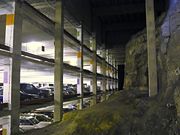
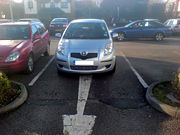
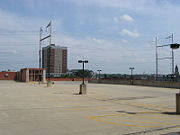
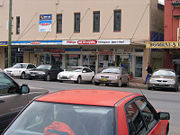

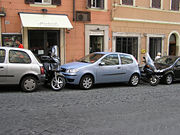
Parking is the act of stopping a vehicle and leaving it unoccupied for more than a brief time. Parking on one or both sides of a road is commonly permitted, though often with restrictions. Parking facilities are constructed in combination with most buildings, to facilitate the coming and going of the buildings' users.
Contents |
Parking facilities
Parking facilities include indoor and outdoor private property belonging to a house, the side of the road where metered or laid-out for such use, a parking lot or car park, indoor and outdoor multi-level structures, shared underground parking facilities, and facilities for particular modes of vehicle such as dedicated structures for cycle parking.
In the U.S., after the first public parking garage for motor vehicles was opened in Boston, May 24, 1898, livery stables in urban centers began to be converted into garages. In cities of the Eastern US, many former livery stables, with lifts for carriages, continue to operate as garages today.
The following terms give regional variations. All except carport refer to outdoor multi-level parking facilities. In some regional dialects, some of these phrases refer also to indoor or single-level facilities.
- Parking ramp (used in some parts of the upper Midwestern United States, especially Minneapolis, but sometimes seen as far east as Buffalo, New York). Elsewhere, the term "ramp" would apply to the inclines between floors of a parking garage, but not to the entire structure itself.
- Multi-storey car park
- Car park (UK, Hong Kong)
- Parkade (Canada, South Africa, Northeastern Pennsylvania)
- Parking structure (Western U.S.)
- Parking garage (Canada and USA, where this term does not always distinguish between outdoor above-ground multi-level parking and indoor underground parking.
- Parking deck (Eastern USA, an outdoor above-ground multi-level parking facility)
- Carport (open-air single-level covered parking)
- Cycle park (UK)
Modes of parking
For most motorised vehicles, there are four basic modes of parking, based on the arrangement of vehicles — parallel parking, perpendicular parking, angle parking, and Anderson parking. These are self-park configurations where the vehicle driver is able to access the parking independently.
Besides these basic modes of motor vehicle parking, there are instances where a more ad hoc approach to arranging motor vehicles is appropriate. For example, in parts of some large cities, such as Chicago, where land is expensive and therefore parking space is at a premium, there are parking lots for motor vehicles where the driver leaves the keys to the vehicle with an attendant who arranges vehicles so as to maximize the number of vehicles that can be parked in the lot. Vehicles may be packed up to five vehicles deep in combinations of perpendicular and/or parallel parking with limited circulation aisles for the parking attendant. Such arrangements are known as attendant parking. When the lot or facility is provided to serve the customers of a business, it is considered valet parking.
Inner city parking lots are often temporary, the operators renting land which is vacant pending the construction of a new office building. Some inner city lots are equipped with individual lifts, allowing cars to be stored above each other.
Another ad hoc arrangement is tandem parking. This is sometimes done with residential motor vehicle parking where two motor vehicles park nose-to-end in tandem. The first motor vehicle does not have independent access, and the second motor vehicle must move to provide access. As with attendant parking, the purpose is to maximize the number of motor vehicles that can park in a limited space.
Parallel parking
With parallel parking of cars, these are arranged in a line, with the front bumper of one car facing the back bumper of an adjacent one. This is done parallel to a curb, when one is provided. Parallel parking is the most common mode of streetside parking for cars. It may also be used in parking lots and parking structures, but usually only to supplement parking spaces that use the other modes.
Perpendicular parking
With perpendicular parking of cars, these are parked side to side, perpendicular to an aisle, curb, or wall. This type of car parking is more scalable than parallel parking and is therefore commonly used in car parking lots and car parking structures.
Often, in car parking lots using perpendicular parking, two rows of parking spaces may be arranged front to front, with aisles in between.
Sometimes, a single row of perpendicular car parking spaces is marked in the center of a street. This arrangement eliminates reversing from the manoeuvre; cars are required to drive in forwards and drive out forwards.
Angle parking
Angle parking of cars is similar to perpendicular parking for these vehicles, except that cars are arranged at an angle to the aisle (an acute angle with the direction of approach). The gentler turn allows easier and quicker parking, narrower aisles, and thus higher density than perpendicular parking. While in theory the aisles are one way, in practice they are typically wide enough to allow two cars to pass slowly when drivers go down the aisles the wrong way.
Angle parking is very common in car parking lots. It may also be used in streetside car parking when there is more width available for car parking than would be needed for parallel parking of cars, as it creates a larger number of parking spaces. Some cities have utilized angled parking on-street (as compared to off-street parking facilities). This has been done mostly in residential, retail and mixed use areas where additional parking compared to parallel parking is desired and traffic volumes are lower. Most angled parking is design in a head-in configuration while a few cities (Seattle and Portland are examples) have some back-in angled parking (typically on hills or low traffic volume streets). u
Anderson Parking
Anderson parking is used for events when all vehicles arrive and depart at the same time. A parking lot that uses this method has one entrance and one exit. The entrance is usually a small road that leads the driver to the back of the parking lot. The first vehicles park in marked spots facing the exit. The following vehicles park behind the cars in tandem leaving an aisle after every two rows. Anderson parking is not used to save space (the same amount of space would be taken if angle parking was used) but it allows large numbers of vehicles to exit the parking lot at the same time efficiently, and it it allows vehicles to leave the event early. This type of parking is often seen at churches and concert halls.
Economics of parking
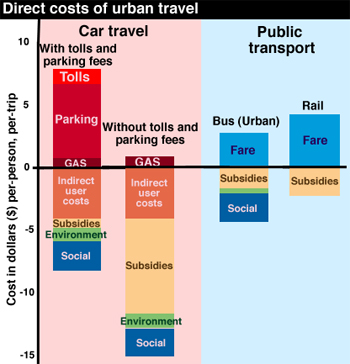
In congested urban areas parking of motor vehicles is time consuming and sometimes expensive. Urban planners must consider whether and how to accommodate or 'demand manage' potentially large numbers of motor vehicles in small geographic areas. Usually the authorities set minimum, or more rarely maximum, numbers of motor vehicle parking spaces for new housing and commercial developments, and may also plan its location and distribution to influence its convenience and accessibility. The costs or subsidies of such parking accommodations can become a heated point in local politics. For example, in 2006 the San Francisco Board of Supervisors considered a controversial zoning plan to limit the number of motor vehicle parking spaces available in new residential developments.[2]
In the graph to the right the value above the line represents the out-of-pocket cost per trip, per person for each mode of transportation, the value below the line accounts for subsidies, environmental impact, social and indirect costs. When cities charge market rates for on street parking and municipal parking garages for motor vehicles, and when bridges and tunnels are tolled for these modes, driving becomes less competitive in terms of out-of-pocket costs than other modes of transportation. When municipal motor vehicle parking is underpriced and roads are not tolled, the shortfall in tax expenditures by drivers, through gas tax and other taxes amounts to a very large subsidy for automobile use. The size of this subsidy for cars dwarfs the federal, state, and local subsidies for the maintenance of infrastructure and discounted fares for public transportation.[1]
Where car parking spaces are a scarce commodity, and owners have not made suitable arrangements for their own parking, ad hoc overspill parking often takes place along sections of road where there is no planned scheme by a municipal authority to formally allocate roadspace to the car. Heated social discourse sometimes revolves around the sense of "ownership" that informally arises amongst individuals displaying overspill parking behaviour. For example, during the winter of 2005 in Boston, the practice of some people saving convenient overspill roadway for themselves, became controversial. At that time, many Boston regions had a tradition that if a person shoveled the snow out of a roadspace, that person could claim ownership of that space with some kind of marker (e.g. a chair or orange cone) in the space.[3] However, city government defied that custom and cleared markers out of spaces.[4] Indeed, parking space in Boston is such a rare commodity that in 2006 a single parking space sold for $250,000.[5]
Festivals and sporting events often spawn a cottage industry of parking. Homeowners, schools, and businesses often make extra money by charging a flat rate fee for all-day parking during the event.
Donald C. Shoup in 2005 argued in his The High Cost of Free Parking against the large consumption of land and other resources in urban and suburban areas for motor vehicle parking.[6] Shoup's work has been popularized along with market-rate parking and performance parking, both of which raise the price of metered street parking with the goal of reducing cruising for parking and double parking.
Amount of parking
Parking generation
Parking Generation refers to a document produced by the Institute of Transportation Engineers (ITE) that assembles a vast array of parking demand observations predominately from the United States. It summarizes the amount of parking observed with various land uses at different times of the day/week/month/year including the peak parking demand. While it has been assailed by some planners for lack of data in urban settings, it stands as the single largest accumulation of actual parking demand data related to land use. Anyone can submit parking demand data for inclusion. The report is updated approximately every 5 to 10 years.
In popular culture
- The song Big Yellow Taxi, originally written and performed by Joni Mitchell, includes the line, "They paved paradise and put up a parking lot."
- The Monopoly board game includes a space called Free Parking. Typically, a player who lands on this space wins a jackpot consisting of a collection of fines and taxes that have been placed in the center of the board instead of being paid to the Banker. Parker Brothers released a card game by the same name as a spin-off of this space.
- A popular parlance for sexual activity in public, derived from the cultural phenomenon of "parking" as depicted in many shows and movies about the 1950s 60s and 70s.
- In an episode of Seinfeld titled The Parking Space, George Costanza says, "You don't understand. A [parking] garage. I can't even pull in there. It's like going to a prostitute. Why should I pay, when if I apply myself, maybe I could get it for free?"
See also
- Alternate side parking
- Automatic parking
- Bicycle stand
- Car condo
- Decriminalised parking enforcement
- Disc parking
- Double parking
- Garage parking
- Lovers' lane
- Overspill parking
- Parallel parking
- Parking lot
- Parking meter
- Parking space
- Parking violation
- Park and ride
- Pullthrough
- Residential zoned parking
- Valet parking
- Parking Guidance and Information Systems
- Disabled parking permit
References
- ↑ 1.0 1.1 Graph based on data from Transportation for Livable Cities By Vukan R. Vuchic page. 76. 1999. ISBN 0882851616
- ↑ Vega, Cecilia (2006-02-07). "Supes to consider limit on parking spaces at new buildings", San Francisco Chronicle, pp. B - 2. Retrieved on 2008-04-10.
- ↑ "Snow chairs". Boston Online. Retrieved on 2008-04-10.
- ↑ Finer, Jonathan (2005-01-01). "Boston Fights Winter Parking Tradition", Washington Post, pp. A02. Retrieved on 2008-04-10.
- ↑ Blanton, Kimberly (2006-11-27). "Sold: 1 open-air parking space in the Back Bay for $250,000", The Boston Globe. Retrieved on 2008-04-10.
- ↑ The High Cost of Free Parking by Donald C. Shoup